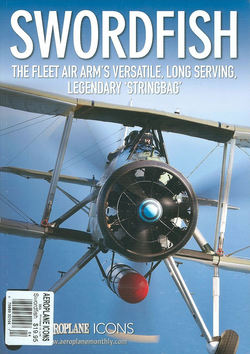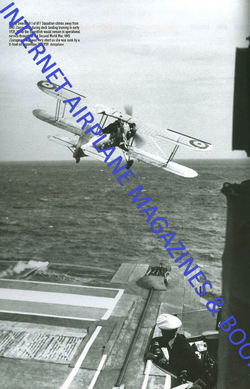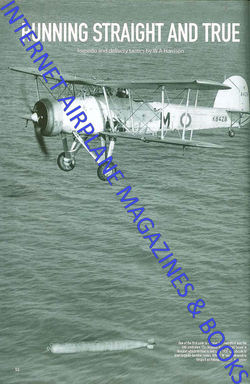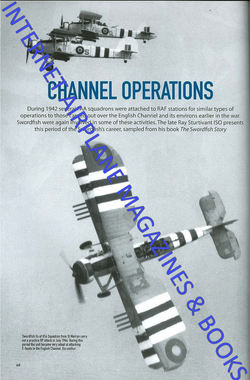AEROPLANE ICON SWORDFISH WW2 RN FAA STRINGBAG TORPEDO BOMBER BISMARCK
U-BOATS CHANNEL DASH
SOFTBOUND BOOK (130
PAGES)
THE SWORDFISH STORY
STRINGBAG JOINS THE
FLEET
TRAINING CARRIER –
HMS COURAGEOUS
SINKING THE BISMARCK
AGAINST ALL ODDS –
THE CHANNEL DASH
TORPEDO DELIVERY
TACTICS
FIGHTING THE U-BOATS
HMS ARGUS TOUR OF
DUTY
THE REMARKABLE
CONCEPT OF THE FLOATING AERODROME
ROYAL NAVY HISTORIC
FLIGHT
SURVIVING SWORDFISH
DETAILED LISTING OF
ALL FRONT-LINE FAA SWORDFISH UNITS, SECOND LINE AND OTHER AIR FORCE SERVICE
-----------------------------------------------------------------------------------------------------------
Additional Information from Internet Encyclopedia
The Fairey
Swordfish was a biplane torpedo bomber designed by the Fairey Aviation
Company, used by the Fleet Air Arm of the Royal Navy during World War II.
Originating in the 1930s, the Swordfish, nicknamed "Stringbag", was
an outdated design by the start of the war in 1939, but remained in front-line
service until V-E Day, outliving several types intended to replace it. It was
initially operated primarily as a fleet attack aircraft; during its later years
it was used as an anti-submarine and training craft.
The Swordfish achieved some spectacular successes,
notably sinking one and damaging two battleships of the Regia Marina (the Italian Navy) in the Battle of Taranto and the
famous crippling of the Bismarck.
The "Torpedo-Spotter-Reconnaissance" prototype TSR II (the PV was the TSR I) first
flew on 17 April 1934. It was a large biplane with a metal airframe covered in
fabric, and utilized folding wings as a space-saving feature for aircraft
carrier use. An order was placed in 1935 and the aircraft entered service in
1936 with the Fleet Air Arm (then part of the RAF), replacing the Seal in the
torpedo bomber role.
The Swordfish was also capable of operating as a
dive-bomber and in 1939 HMS Glorious
used her Swordfish for a series of dive-bombing trials, during which 439
practice bombs were dropped at dive angles of 60, 67 and 70 degrees, against
the target ship HMS Centurion.
Tests against a stationary target showed an average error of 49 yd
(45 m) from a release height of 1,300 ft (400 m) and a dive
angle of 70 degrees. Tests against a manoeuvring target showed an average error
of 44 yd (40 m) from a drop height of 1,800 ft (550 m) and
a dive angle of 60 degrees.
By 1939, the Fleet Air Arm (now under Royal Navy control)
had thirteen squadrons equipped with the Swordfish Mark I. There were also three flights of Swordfish
equipped with floats, for use off aircraft catapult-equipped warships. One from
HMS Warspite spotted fall
of shot and radioed gunnery corrections back to the ship during the Second
Battle of Narvik in 1940, and subsequently sank the U-boat U-64. The Swordfish pioneered the use
of air to surface vessel radar (ASV) by carrier-borne aircraft to locate
surface ships at night and through clouds.
Swordfish flew from merchant aircraft carriers ("MAC
ships"), twenty civilian cargo or tanker ships modified to carry three or
four aircraft each, on anti-submarine duties with convoys. Three of these ships
were Dutch-manned, flying Swordfish from 860 (Dutch) Naval Air Squadron. The
others were manned by pilots and aircrew from 836 Naval Air Squadron, at one
time the largest squadron, with 91 aircraft.
When production ended on 18 August 1944, almost 2,400 had
been built, 692 by Fairey and 1,699 in Sherburn by the Blackburn Aircraft
Company. The most numerous version was the Mark II, of which 1,080 were made.
The primary weapon was the aerial torpedo, but the low
speed of the biplane and the need for a long straight approach made it
difficult to deliver against well-defended targets. Swordfish torpedo doctrine
called for an approach at 5,000 feet (1,500 m) followed by a dive to
torpedo release altitude of 18 feet (5.5 m). Maximum range of the early
Mark XII torpedo was 1,500 yards (1,400 m) at 40 knots (74 km/h;
46 mph) and 3,500 yards (3,200 m) at 27 knots (50 km/h;
31 mph). The torpedo travelled 200 yards (180 m) forward from release
to water impact, and required another 300 yards (270 m) to stabilise at
preset depth and arm itself. Ideal release distance was 1,000 yards
(910 m) from target if the Swordfish survived to that distance. On 11
November 1940, Swordfish flying from HMS Illustrious made a very significant strike against the Italian
navy at Taranto, sinking or disabling three battleships lying at anchor. In the
aftermath, the Japanese naval attache from Berlin visited Taranto; he later
briefed the staff who planned the attack on Pearl Harbor. Swordfish also flew
anti-shipping sorties from Malta.
In May 1941, Swordfish participated in the pursuit and
sinking of the German battleship Bismarck.
On 25 May, nine Swordfish from HMS Victorious
attacked Bismarck, scoring one
torpedo hit but only minor damage. On 26 May, Ark Royal launched two Swordfish strikes against Bismarck. The first failed to find Bismarck. The second strike scored
two hits, one of which jammed Bismarck's
rudders with 15° port helm on. This made Bismarck
unmanoeuvrable, and unable to escape to France; it sank after intense Royal
Navy attack within 13 hours. The low speed of the attacking aircraft may have
acted in their favour, as the planes were too slow for the fire-control
predictors of the German gunners, whose shells exploded so far in front of the
aircraft that the threat of shrapnel damage was greatly diminished. At least
some of the Swordfish flew so low that most of Bismarck's flak weapons could not depress enough to hit them.
The problems with the aircraft were starkly demonstrated
in February 1942, during the Channel Dash. Six Swordfish led by Lieutenant
Commander Eugene Esmonde attacked the German battleships Scharnhorst and Gneisenau, resulting in the loss of
all aircraft with no damage to the ships. Lack of fighter cover was a
contributing factor; only ten of eighty-four promised fighters were available.
Thirteen of the eighteen Swordfish crew were killed; Esmonde, who had also led
an attack on Bismarck, was
awarded the Victoria Cross posthumously. The courage of the Swordfish crews was
noted by the commanders on both sides: British Vice-Admiral Bertram Ramsay
later wrote "In my opinion the gallant sortie of these six Swordfish
aircraft constitutes one of the finest exhibitions of self-sacrifice and
devotion to duty the war had ever witnessed," and German Vice-Admiral Otto
Ciliax remarked on "the mothball attack of a handful of ancient planes,
piloted by men whose bravery surpasses any other action by either side that
day."
After more modern torpedo attack aircraft were developed,
the Swordfish was soon redeployed successfully in an anti-submarine role, armed
with depth charges or eight "60 lb" (27 kg) RP-3 rockets
and flying from the smaller escort carriers, or even Merchant Aircraft Carriers
(MAC) when equipped for rocket-assisted takeoff (RATO). Its low stall speed and
inherently tough design made it ideal for operation from the MAC carriers in
the often severe mid-Atlantic weather. Indeed, its takeoff and landing speeds
were so low that, unlike most carrier-based aircraft, it did not require the
carrier to be steaming into the wind. On occasion, when the wind was right, Swordfish
were flown from a carrier at anchor.
Swordfish-equipped units accounted for 14 U-boats
destroyed. The Swordfish was to be replaced by the Fairey Albacore, also a
biplane, but outlived its intended successor, and was succeeded by the Fairey
Barracuda monoplane torpedo bomber.
The last of 2,392 Swordfish aircraft were delivered in
August 1944. Operational sorties continued into January 1945 with anti-shipping
operations off Norway (FAA Squadrons 835 and 813), where the Swordfish's
manoeuverability was essential.
Towards the end of the war, No. 119 Squadron RAF operated
Swordfish Mark IIIs, fitted with centimetric radar, from airfields in Belgium.
Their main task was to hunt at night for German midget submarines in the North
Sea and off the Dutch coast. The radar was able to detect ships at a range of
around 25 miles (40 km). One of the aircraft operated by 119 Squadron in
this role survives and is part of the collection of the Imperial War Museum.
The last operational squadron
was disbanded on 21 May 1945, after the fall of Germany, and the last training
squadron was disbanded in the summer of 1946.














